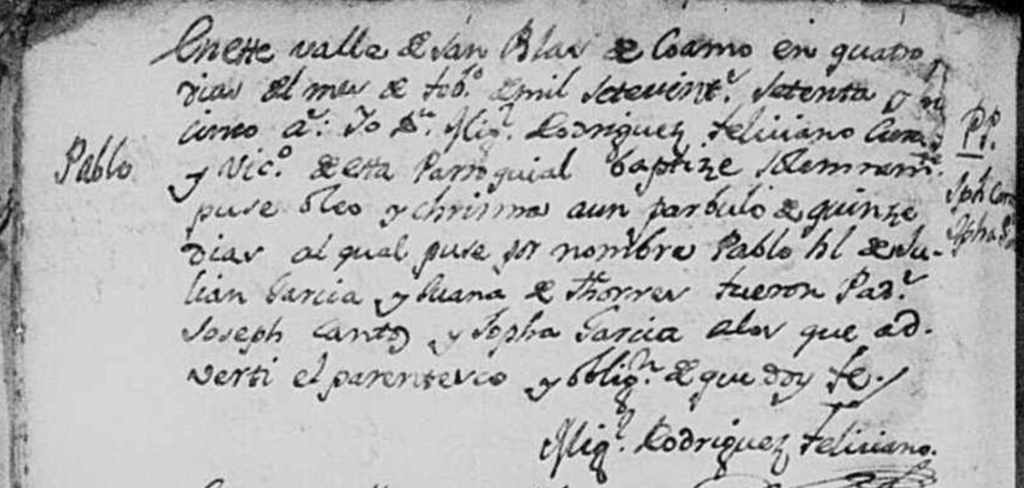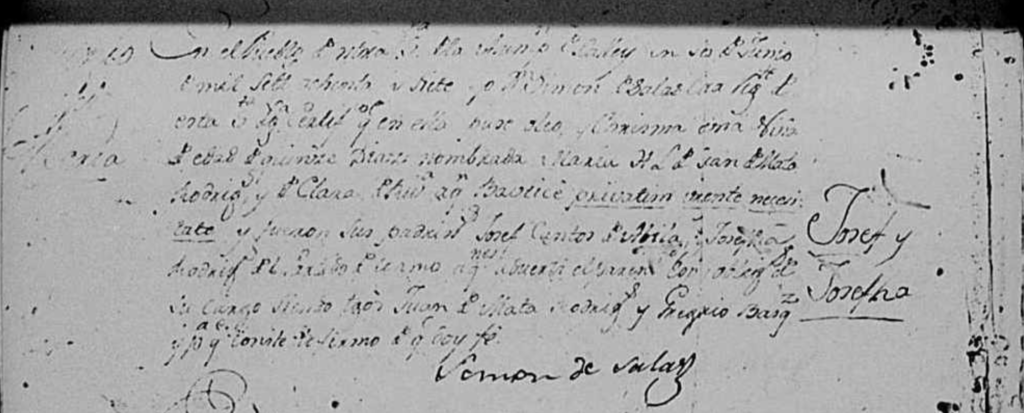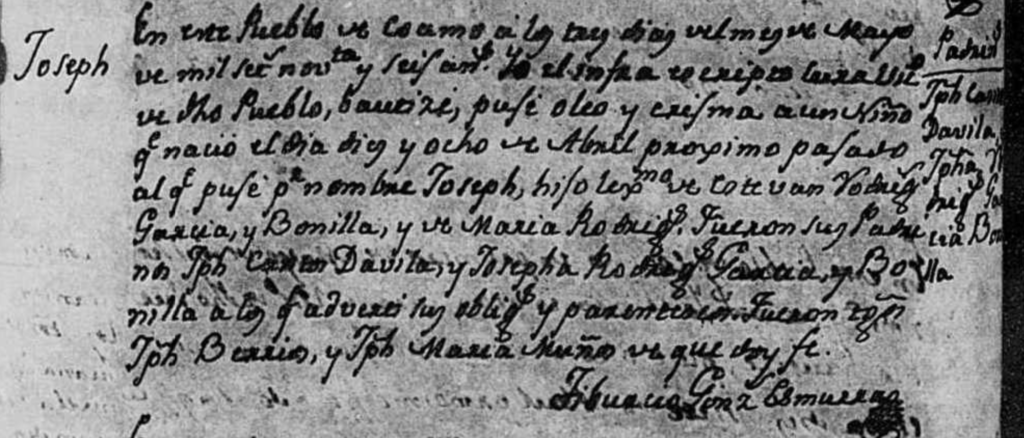I’m not gonna lie — I have hesitated so many times in writing this post. First, I created the post itself and saved it under drafts for two years (enter the pandemic and other life events), after I began doing some research on the family and then stopped. Lastly, I created a file for them where I could compile all of the information and once again stopped. Why? Because this has been one of the most convoluted families I have tried to research in my family which ultimately has lead me to multiple dead ends!
The confusion lies in two main issues: (1) The use of three surnames either all at once or in rotation (two of which are very common surnames!) and (2) the lack of documentation from that time period.
What I will do is start slowly with what I already know and then go from there. Hopefully I will not confuse myself or you, the reader!
Ancestor in question -
Josefa García?
Rodríguez? Bonilla?
This branch of the family I was able to discover as I learned that my family before living in Maunabo, had lived in Coamo – specifically tied to my Dávila branch of the family which I later learned originated in Spain which I was then able to travel abroad and do research on. Three separate posts have been hyperlinked if you are interested in reading more!
My ancestor Bartolomé Dávila/Cantos García was the son of José Dávila/Cantos and Josefa García. I have tracked Josefa so far to six children (five baptisms, 1 marriage) for which I can confirm that she had in Coamo. For some children I have both a baptism and a marriage and for one child, just a marriage. Sadly since most of the family moved to Maunabo, there are no death records available on FamilySearch from that time period. I also called the church and the person working in the office said they did not have any either.
Here is how Josefa appeared in those baptisms and marriages.
Baptisms
1775 – Josefa García
1780- Josefa García
1783 – Josefa Rodríguez
1785 – Josefa Rodríguez
1788- Josefa García
Marriages
1796 – Josefa García Rodríguez Bonilla
1806 – Josefa García Rodríguez Bonilla
1815- Josefa García
In order to hopefully provide some way of tracking names I have given each surname a color so that it is easier to visually see. Notice that “Bonilla” is not as commonly used and it comes only after “Rodríguez“. Similarly, “García” seems to be her preference (appearing four times independently) though at times she had preferred to use “Rodríguez” by itself (twice only). What’s interesting to me is that she only appeared with all three surnames in two marriages.
Below are two screen shots where her name appears with all three surnames in marriage records in Coamo, Puerto Rico between the 18th-19th century. You will notice in the first record that her name was written as “Josepha” – common to see in records from that time period and you can also discern that Rodríguez was written as “Rodrigs” with the “s” as a superscript letter (name spelling varied at the time as well, so a surname could be spelled Rodríguez or Rodrígues). “Rodrigs” was a shorthand form back in the days to write this surname and even occurred sometimes with names such as “Fran/co” with the “co” superscripted for a shorthand of the name Francisco. The second document is extremely difficult to read and really only with the grace of God is how I was able to even see their names on the document. You have to play a bit with the image’s settings on FamilySearch to truly be able to see parts of the name.


Surname Traditions
The Wikipedia page has a section for the Iberian Peninsular tradition when it comes to using double-barrelled surnames. One section talks about apellidos compuestos which are surnames that are already combined. They provide an example of a Spanish Prime Minister whose name was Leopoldo Calvo-Sotelo y Bustelo, the “Calvo-Sotelo” part coming from his father and “Bustelo” from his mother.
We also have cases of this happening in Puerto Rico, a few examples I know are Ramírez de Arellano, Aponte de Ramos, Pérez de la Cruz, Colón de Luyando, and López de Victoria. These are surnames that were transmitted to the next generation just like that, attached. Yet over time they have been simplified and one part of the surname was dropped. For example, my own 6th great-grandfather was named Francisco Pérez de la Cruz y Santiago (abt 1763-1828), his parents were Simón Pérez de la Cruz and María Santiago. By the time my 4th great-grandfather was around in the mid-late 1800s, the surname was shortened to just “Pérez”.
This leads me to wonder if this is the case with Josefa, could she have been “García” via her father and “Rodríguez Bonilla” via her mother or vice versa? Are there questions of paternity and legitimacy as well? Could she have been recognized by her parents later in a marriage which caused her to jump back and forth between García and Rodríguez? Or was the family previously enslaved which caused them to bounce around surnames as well?
FAN CLUB of
Josefa García Rodríguez Bonilla
One way to better understand a family and their surroundings (both socially and family wise) is to use what is known as the “FAN Club” which stands for “Friends, Associates, and Neighbors”. These would be people that have some type of association with the person you are researching. Since I am mainly using baptismal records between the 18th-19th century (census records did not exist how we know them today), I rely mainly on the baptisms to find godparents who tend to be sometimes related somehow to the couple when surnames are shared. I have used this method before when talking about my Rivera Román family who likely had ties to the Román Ayala family from Arecibo, Puerto Rico.
Godparents for the
Dávila García children
From the five children I have baptism records for I gleamed over the godparents to see if there was any overlap for José Dávila/Cantos and Josefa García. So far I was able to identify two couples:
1780 – Baptism of Juan (Juan Ortiz & María Concepción García)
1785 – Baptism of Hilario (Juan Pacheco & Josefa Rodríguez)
The problem here is also that these surnames are very common in Puerto Rico. So while they might be a clue, the odds that there is a coincidental overlap unfortunately is fairly high!
Interestingly, Juan Ortiz and María Concepción García have children in Coamo and in 1758 she is listed as María de la Concepción Bonilla! The godmother to that child is a “María Bonilla“. However, I have nothing else on the couple to help tie them to Josefa.
Looking for children between Juan Pacheco and Josefa Rodríguez I do not find any which could mean 1) they moved to another town or 2) they were not married when they came forward to be godparents. I know she is not my 6th great-grandmother because by 1785 my Josefa had already had her own children and she was appearing as married.
La Madrina:
Josefa García Rodríguez
The same can be searched in reverse, did Josefa serve as a madrina or godmother for other children in Coamo and did she share a surname with either the father or the mother of the child?
For example, Josefa served as a madrina in December 1806, she was partially (I’ll explain) the godmother to Luis Aponte Dávila (likely his name though hard to make out in the document), a son born to Bernardino Aponte de Ramos and Marcelina Cantos Dávila. Luckily, I know that the “Cantos Dávila” branch is very small and so Marcelina is already likely related to me. The other people listed as godparents were Bartolo Cantos and Catalina Cantos – both children of José Cantos Dávila and Josefa García (I know this because I have baptisms and marriages to prove their relationship). Equally we know that Marcelina was a daughter of José Cantos Dávila and Josefa García. So in this case, we see Josefa García coming forward as the grandmother to support Bartolomé and Catalina as godparents to their nephew.
This is why the FAN Club is important – it helps to identify family relationships and to discover potential other siblings, uncles/aunts, cousins, etc. closely related to the family.
Josefa appeared three times for baptisms for people with the surnames either García, Rodríguez, or Bonilla:
1775- Baptism of Pablo, son of Julián García & Juana de Torres
1787- Baptism of María, daughter of Juan de Mata Rodríguez & Clara de Rivera
1796- Baptism of José, son of Esteban Rodríguez García Bonilla & María Rodríguez
The next step would be to try and figure out who these people are – how are they connected to Josefa? Are they brothers, cousins, or uncles to her? So I figured I would divide the next sections to each found person and see what comes from the search!
A quick side-note: it’s interesting seeing Bonilla appear after García here for Esteban so let’s see if this continues throughout his research!
Julián García
I was able to find a death record of a Julián Bonilla who died in Coamo in 1818 widower of Juana Torres, the record mentioned eight children produced from their marriage: Francisco, Pablo, Clemente, Olaya, Manuela José, Lino, Gerónima, and Casimira. There are transcribed Coamo baptism records covering the 18th century and so I searched for either Julián García, Julián Bonilla, or Julián Rodríguez and this is what I was able to find:
Julián García (Confirming three children + three others found)
1772 (Francisco)
1775 (Pablo)
1782 (José)
1784 (Juan Silvestre) gemelo (twin)
1784 (María Silvestra) gemela (twin)
1789 (María)
1793 (Gerónima)
Julián Bonilla (confirming two child)
1780 (Olaya)
1787 (Lino)
Clemente married in 1825 to Andrea Mateo as Clemente Bonilla.
Julián Rodríguez (confirming one child)
1786 (Manuela de Jesús)
Currently, Casimira is the only one missing to identify.
From all of the children presented, Pablo in 1775 is baptized and received the godparents José Cantos & Josefa García.

Unfortunately, Julián’s death record does not mention his parents’ names, however, he is listed as 90 years old making him born about 1728.
Side note: Josefa was born likely around the 1730-1740s herself based on the years she started having children.
Juan de Mata Rodríguez
Juan de Mata Rodríguez married in Cayey, Puerto Rico – a neighboring town of Coamo. He is listed as the son of Bernabé Bonilla and Rosa María Rodríguez, residents of Coamo. What is interesting to note is that even in the marriage record they use BOTH surnames separately (Rodríguez and Bonilla) for the son and father – did they even realize this when writing it? One would think, well Juan de Mata uses his mother’s name, except other evidence shows that Bernabé himself used both Rodríguez and Bonilla.
It seems that Juan de Mata and his wife Clara stayed in Cayey for most of, if not, the rest of their lives. There they had various children all born with the surname “Rodríguez”:
1782 (Francisco)
1785 (Juan)
1787 (María)
1789 (Simón)
1791 (Tomasa)
Out of the five children listed above, Josefa served as the godmother for María in 1787, she was listed as “Josefa Rodríguez” along with her husband “José Cantos de Ávila”. What is interesting is that though José and Josefa are listed as residents of Coamo, María’s baptism was done quickly out of necessity. Could they have already been visiting Juan de Mata and his wife Clara when their daughter’s health took an unexpected turn?

The most important information to gleam from Juan de Mata Rodríguez’s marriage record is that we NOW have names for a potential set of parents, grandparents, uncle/aunt etc. tied to Josefa García – Bernabé Bonilla (potentially Rodríguez Bonilla) & Rosa Rodríguez.
Esteban rodríguez garcía bonilla
To make matters more… interesting… this where everything goes (back to the drawing board, to put it nicely).
Esteban appearing with all three names should be a dead giveaway that he and Josefa are related, right?? But for some reason (of course there is always one!) I can not for the life of me tie him and Josefa together.
For starters, Esteban and his wife María Rodríguez had three children known to date:
Esteban Rodríguez
1794 (Ramón)
Esteban Rodríguez García Bonilla
1796 (José)
Esteban García
1793 (Victoriana)
José baptized in 1796 and was assigned the godparents José Cantos Dávila & Josefa Rodríguez García y Bonilla. Interestingly, they separate Bonilla with a “y” usually showing that this second surname should belong to the mother; the same is done for Esteban in the baptism.

Here is where it gets interesting! A marriage record appears in 1792 in Coamo for a Esteban Rodríguez and María Estanislada Rodríguez, except the record listed Esteban as a natural son of a Josefa García. HUH?!? If we are talking about the same Esteban… where are the surnames Rodríguez and Bonilla?
No matter how I spin it I can not figure out why this is so. Especially since Esteban got married in 1792 and by then we already see the surname in all its variations which would lead me to believe that if the parents were not married, they would have already done it by 1792. Similarly Juan de Mata’s parents are Bernabé Rodríguez/Bonilla and Rosa María Rodríguez – no use of García appears for them so far.
Potential hypothesis: That Josefa García we see appearing with Juan Pacheco in 1785 as the godmother of Hilario – could she be related to Esteban somehow and was entirely another person from my 6th great-grandmother? Especially given Esteban’s age (born about ~1770s), could he actually be a nephew and not a sibling to my Josefa García?
An extra puzzle piece
In searching for more potential leads, we come across two extra baptisms from a completely differently couple. This couple is Juan Colón de Luyando & Juliana Rodríguez Bonilla/Juliana García.
Juan Colón & Juliana García
1777 (José)
Juan Colón de Luyando & Juliana Rodríguez de Bonilla
1780 (Sabina)
Sabina’s godparents were Juan de Mata Rodríguez Bonilla & María Colón. We know this couple already because Josefa served as godmother for one of their children. It is interesting that Colón appears in both couples as well!
José’s godparents in 1777 are none other than José Cantos & Josefa García. Notice that both Juliana and Josefa here appear as García together in that record!
Juliana Rodríguez Bonilla
Juliana died in Coamo, Puerto Rico in December 1816 and was listed as Juliana Bonilla. Her death record stated she was 70 years old, the daughter of Bernabé Bonilla and Rosa María Rodríguez, the widow of Juan Colón. Five children were listed on her death record: Valentín, Manuel, Juan Luciano, Francisca, and Sabina.
So now we know that Juliana and Juan de Mata are actually siblings!!
Where to now?
There is still much to be learned! Some other Rodríguez Bonilla appear in Coamo but I have yet to tie them together as well – I think though they are the children of the generation I seem to have found that might be all related. Juan de Mata and Juliana fit perfectly as siblings but where does that leave Esteban? Could there actually have been two Estebans who I am confusing? What about my Josefa – was she also the daughter of Bernabé Rodríguez Bonilla and his wife Rosa María Rodríguez? Or was she related to them but not directly as parent-child? Similarly, Julián García/Rodríguez Bonilla – was he also the son of Bernabé and Rosa María Rodríguez? I have a secret feeling he is, especially since Bernabé and Rosa had a daughter named Juliana!
I am indifferent about ending this post without a clear solution. Mostly because it has eaten up so much time of my research and that I have yet to close the case. I can not say for sure that Bernabé and Rosa are my 7th great-grandparents because I have no direct proof yet. Maybe I am really bothered by this because Josefa’s husband José is also enigmatic because though I have a lead to a town in Spain… I’m not sure if it’s the right man!
So – I will publish this with no clear solution and hope that in the future, I will be able to solve this mystery once and for all! Until then I will have to continue using the triple surnames for my 6th great-grandmother – Josefa García Rodríguez Bonilla.
